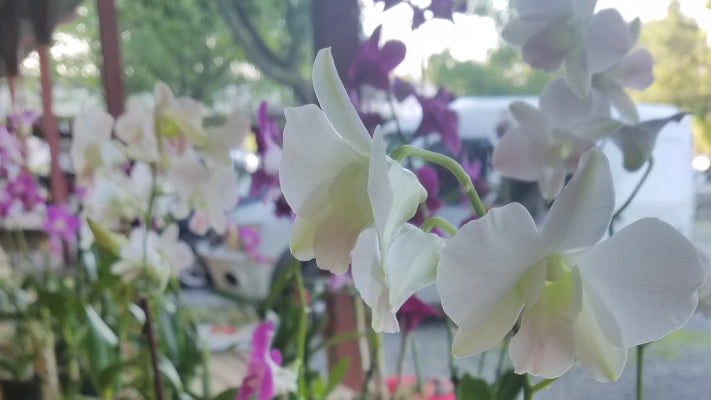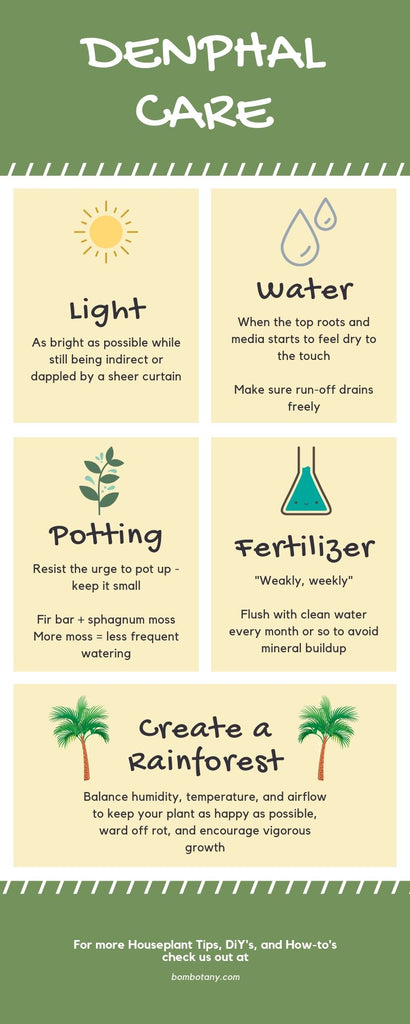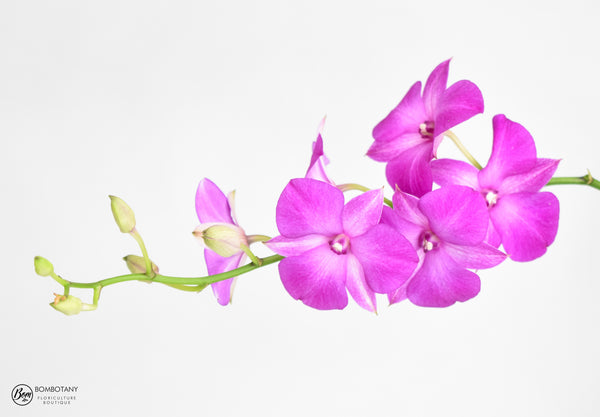
Dendrobium Phalaenopsis Complete Care Guide

Phalaenanthe orchids are hard-cane and evergreen, usually with tall and slender pseudobulbs. Flowers spike from near the top of a cane, with an arching stem. I wish those stems would just grow straight! Flowers are large and petals wide, much like Moth orchids, which is why they’re called Dendrobium phalaenopsis! To make things even more confusing, more recent nomenclature is Den. bigibbum var. superbum. Thankfully hobbyists stick to “Den-Phal”.
It’s Dendrobium > Phalaenanthe > Dendrobium phalaenopsis.
Whew!
New canes which have just finished growing will reward you with inflorescence about three times a year with proper care! Den-Phal orchids are an absolute staple that every collector should have. They’re an excellent first choice for enthusiasts looking for something more unique than your standard grocery store orchid. Dendrobium phalaenopsis, the “Cooktown Orchid”, is even the floral emblem of Queensland, Australia! While there are a few quirks that you’ll want to pay attention to, care is generally easy, growth is predictable and manageable. Very long-lasting flowers make this entry-level orchid one of the most gratifying breeds around. Their especially tall and unique composition will have friends asking you “What is THAT?”. I know mine do!
Light
Bright, bright, bright – but not direct!
- East windows are fantastic – morning sun is more gentle than midday rays
- South windows dappled by a sheer curtain work just as well
- Maximize the length of light your plant gets (especially if you live somewhere the days grow shorter than 10 hrs)
Den-Phals are native to Southeast Asia, where the days are very consistent throughout summer and winter. It’s surprisingly hard to burn some varieties, but flower longevity goes down the drain very quickly if your plant is in direct light. In the summer, depending on where you are, noontime sun is so high in the sky that southern exposures are shady. In the winter, days are shorter and the sun comes in at a lower angle – so be conscious of shadows blocking your plant’s exposure. All indoor gardeners should keep their eye on the sun year-round (not literally though… ouch) to make sure they’re doing right by their green friends.
If you live in Northern U.S. and Canada, you might find yourself forced to the southern window in the dead of winter. Many growers experiment with full sun in the winter with minimal issues. In our Pennsylvania greenhouse, we keep our Den-Phals under direct light, dappled by 40-60% shadecloth depending on the time of year. I keep my personal phalaenopsis type Dendrobiums in a southeastern window year-round, and have yet to burn a single leaf.

Dendrobium phalenopsis Lai Klang Oon
Water
As with most plants, it’s a good idea to water while the sun is still up to give the foliage a chance to dry out. Watering frequency could be anywhere from 3 days to a week depending on the evironment. Most important are humidity, heat, and type of pot and media used. The general rule of thumb is to feel your plant’s top roots – phalaenopsis type Dendrobiums like to be mostly dry before watering. Run water through the pot, thoroughly saturating things until water starts draining freely from the bottom. NEVER let your orchids stand in water. While they do like humid conditions, keeping your plant wet for extended periods of time earns you a one-way ticket to Root Rot Town. From there your Dendro will catch the early bus to Trash Can City!
Potting & Soil
Almost all orchids do best in fir bark chips. They last about 3 years before significant deterioration, are packed with plenty of nutrients, and create the naturally airy environment our orchids are used to. For indoor Den-Phals, sphagnum moss has the extra moisture retention that you might be looking for. Our indoor Den’s in fir bark need water every 3 days. Conversely, we have some in 30% sphagnum moss, and they only need water once per week. The ratio is up to you – but less is more. You can always throw in a humidity tray and tighten up your watering schedule, but you can’t easily cure rot. On that note, invest in a humidity tray and one of those digital humidity/temperature monitors. You can pick one up at any garden center. Mini monitors are incredibly cheap on the internet, and you can put them all over your grow space!
Den-Phals prefer tightly packed pots, so resist the urge to pot up! We have 30″ tall plants in 4″ pots in our greenhouse. You will, however, want to replace your potting media every 1-3 years depending on what you’re using. Organics break down relatively quickly (which is a good thing as far as nutrient uptake goes). If that’s not sounding fun to you – check out hydroton and other decomposition-less alternatives. When the plant begins growing over the edges of your pot, that’s when its finally time to go a small step up in size. Dendrobium phalaenopsis orchids are epiphytes, meaning they grow on trees in the wild, so expect aerial roots out the wazoo! Den-Phals are known for their amusingly disproportionate pot-to-plant size ratio.
Fertilizer
If you want to keep things simple, fertilize your orchid with general purpose (i.e. 10-10-10, 20-20-20 “NPK” numbers) liquid fertilizer at 1/4 to 1/2 strength every time you water. Dendrobium orchids are prone to flower at least once a year with adequate sunlight and the nutrients they absorb from media, but a truly healthy plant requires some coaxing. It’s never a good idea to fertilize a flowering or blooming plant. About once a month flush the potting media thoroughly with fertilizer free water to remove chemical buildup which can throw your Dendro on a trip to the wild side. Liquid fertilizer works best for us – it’s easier to dial in the concentration, and to catch and reuse runoff for other plants.
If you feel like taking things a step further, look for a fertilizer with higher levels of nitrogen (i.e. 20-10-10). Orchids love nitrogen, and use it for more vigorous root and foliage growth! There are also heavily diluted fertilizer mists that make for great topical foliage and aerial root care (0.02-0.02-0.02). Play around with mixing your own fertilizer concentrations – NPK numbers refer to the percentage of nutrients in the solution. Making a light fertilizing mist means diluting your concentrated fertilizer with large amounts of water.
Don’t underestimate the value of fresh potting media! Fir bark and sphagnum moss deteriorate just the same as all things organic. At a certain point, you’ll end up with a pot full of completely depleted, fine-grain waterlogged uselessness that can kill your orchid! Decomposition yields high amounts of ammonium – so avoid ammonium-based fertilizers like the plague!
Propagation
Like ginger, turmeric, banana trees, and almost all orchids, Dendrobium orchids grow via a rhizome just under the soil line. New canes sprout upward while the rhizome grows ever horizontally. Starting new plants is as easy as cutting a bit of the rhizome away with some roots and a variety of good canes, then potting your new plant in wet media. Alternatively, try growing clones called “kiekis” (Hawaiian for “young one”) using specially formulated kieke paste on growth nodes. This way you keep your fine, bushy collection of canes! Be warned though – growing a clone drains a lot of your plant’s resources, and almost always postpones flowering. Kiekis can form naturally when an orchid is under unusual stress or grown in hot conditions. However your kieke came to be, it’s important to let it grow a few shoots of several-inch-long roots before separating it from the mother and potting it.
Dendrobium Classic Gem
Everything Else
Dendrobium phalaenopsis are warm weather orchids native to Southeast Asia and Northern Australia. Remember that, and always try to mimic their natural environment whenever possible! They do best around 65 to 85 degrees, with slight temperature drops during nighttime. Humidity should be somewhere in the 50-60% range. Indoor conditions are always lower than that, especially in the winter, so if you’re looking for ways to keep your plant that extra bit healthier, start with a humidity tray. High temperatures make for an orchid that dries out quickly. High humidity creates an environment prone bacterial infections, disease and rot. If you want to have your orchid and eat it too, proper airflow is key (…what?). Consider adding a small fan to your space, or keeping your orchids in porous terracotta pots. While you may need to water more frequently, terracotta breathes so well that your local humidity will raise about 10%.

We love orchids.
We love caring for them, we love learning about them.
We specialize in Dendrobium phalaenopsis orchids – easily the most rewarding variety.
We have a line of rare and exciting Dendrobium phalaenopsis orchids that you might just be interested in!
Get in touch with us!
Accepted Payments:

Leave a comment: